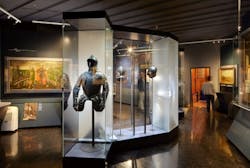UNESCO site Wartburg Castle gets LED lighting for 300 exhibits and common areas
Zumtobel supplied luminaires from the Supersystem II SSL product family to the UNESCO World Heritage Site to improve the visitor experience, deliver energy savings, and enable flexibility for new exhibits.
Zumtobel has announced a retrofit to LED-based lighting at Wartburg Castle in Germany — the UNESCO (United Nations Educational, Scientific and Cultural Organization) World Heritage Site that reflects almost 1000 years of German history. Perched above the city of Eisenach in the state ofThuringian, the castle interior now features solid-state lighting (SSL) for 300 exhibit areas as well as in the common areas of the venue.
The Wartburg Castle complex dates to the 12th century and is where Martin Luther translated the New Testament of the Bible into German and laid the foundation for a standardized German language. The site remains the top Luther-centric historic venue in the world and is hosting a special exhibition entitled “Luther and the Germans” tied to the ongoing Year of Martin Luther celebration.
The castle is not Zumtobel’s first major project at a UNESCO World Heritage Site. For example, we covered a project at the Aachen Cathedral Treasury where Zumtobel LED products delivered energy savings and better lighting for what was once the favored home of Charlemagne.
Germany's Wartburg Castle, a UNESCO World Heritage site, now features interior
LED lighting installed in a manner that respects the site's protected historical status.
(Photo credit: Wartburg-Stiftung Eisenach)
At Wartburg, Zumtobel Supersystem II luminaires are delivering improved lighting for the exhibit areas that total 1000m2. The SSL product family comprises miniaturized and modular products that enable many accent and direct lighting effects and scenes to be installed on low-voltage tracks. For example, the miniature spotlights only extend 45 mm below the track and the track extends 30 mm below the surface upon which it is mounted. The tracks are available in lengths as short as 26 mm and in larger sizes.
The LED lighting replaced a 20-year-old legacy system, and as we have noted in coverage of other historic sites, the low-power requirements of SSL are often a critical element of the selection criteria. There would not have been an option to add more power cables in the castle, but the LED lighting easily could be driven by existing wiring.
The LED lighting scheme relies on Supersystem II luminaires by Zumtobel that
feature a low profile and modular capabilities to illuminate exhibits with the
viewing experience and artifact preservation top of mind. (Photo credit: Zumtobel.)
Of course, historic sites also raise the issue of preserving the exhibits. In the German project, the team added potentiometers to each luminaire, enabling precise control of light levels to a maximum of 50 lx. The optical accessories and luminaire design, meanwhile, restrict light to just where it’s intended for an optimum viewing experience.
The wide variety of products in the Supersystem II family further provided a choice of finishes that could be tailored to match colors and the setting for each exhibit area. Moreover, the modular system could enable the curators to change the lighting for new exhibits in the future.
We’ve covered SSL projects at a number of other UNESCO sites in both indoor and outdoor settings. A few years back, we covered an outdoor project at the Durham Castle and Cathedral in England. And LED lighting of the Moroccan Walls of Rabat was another very impressive SSL project at a UNESCO site.

Maury Wright | Editor in Chief
Maury Wright is an electronics engineer turned technology journalist, who has focused specifically on the LED & Lighting industry for the past decade. Wright first wrote for LEDs Magazine as a contractor in 2010, and took over as Editor-in-Chief in 2012. He has broad experience in technology areas ranging from microprocessors to digital media to wireless networks that he gained over 30 years in the trade press. Wright has experience running global editorial operations, such as during his tenure as worldwide editorial director of EDN Magazine, and has been instrumental in launching publication websites going back to the earliest days of the Internet. Wright has won numerous industry awards, including multiple ASBPE national awards for B2B journalism excellence, and has received finalist recognition for LEDs Magazine in the FOLIO Eddie Awards. He received a BS in electrical engineering from Auburn University.






